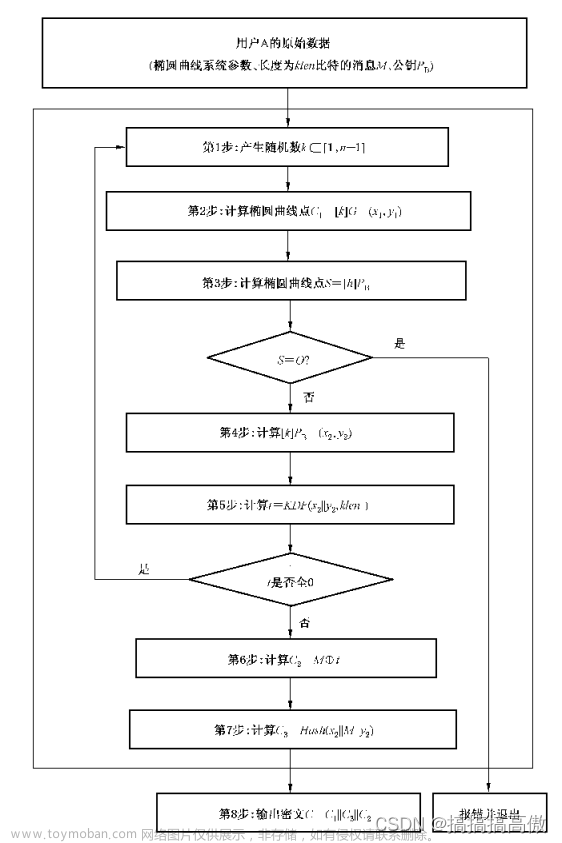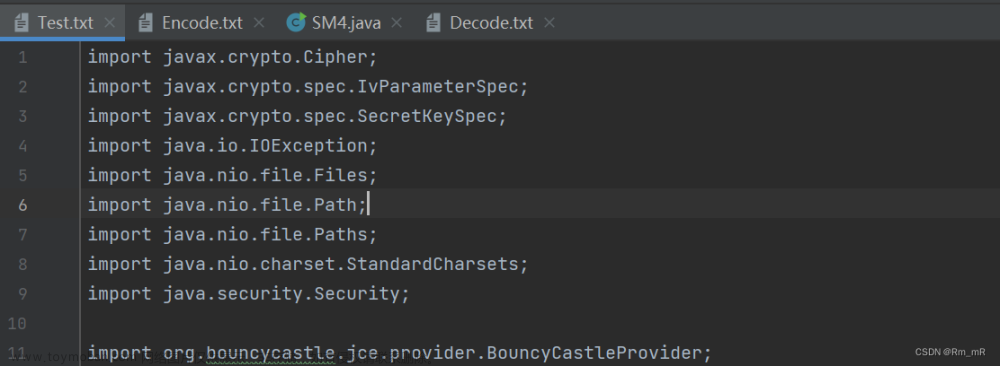因为某些不可抗原因,友商加密平台系统无法提供接口进行加密验签,以至于需要自己实现监管要求的加密验签。
接口要求,报文先经过sm2生成签名,之后进行sm4加密。收到报文后,先进行sm4解密,解密后将报文进行验签。验证成功之后既结束全部流程。
所以整体上分为两大部分,一为sm4加密,二为sm2签名。
首先先说简单的sm4加密,调用代码参考了开源项目openssl。
1.准备密钥和需要加密的报文
2.将报文进行分组,每16个字也就是128bit为一组,这里采用最简单的ECB分组方式,对不足16位的最后一组进行补位,采用pkcs7方式进行补位,就是差几位就补几位的几,比如8位差八位,就补八个八,对于16整数倍补16位的16(方便解码)
3.生成轮密钥,将32位的密钥分成八位一组的四组,编号为k0k1k2k3,通过互相运算及s盒,得到k4,再选取k1k2k3k4,运算得到k5,。循环32次,得到k0-k35,选取k4-k35为生成的轮密钥结果
4.进行加密,同样将一组16个字也是32位分成八位一组的四组,轮加密Bi⊕F(B(i-1)⊕B(i-2)⊕B(i-3)⊕k(i-4))得到下一组,最终得到B31-B35,拼成一个串返回这一组的加密结果,单组加密完毕。
最终把所有组拼在一起就是加密结果。
解密正好相反,因为必然是16的整数倍,所以直接分组。将生成的轮密钥与加密后的报文进行逆运算,最终得到补码后的原报文,取报文最后一位,截取最后一位对应的数字得到原始信息文章来源:https://www.toymoban.com/news/detail-519148.html
参考代码:文章来源地址https://www.toymoban.com/news/detail-519148.html
#include "e_os2.h"
#include "sm4.h"
#include <string.h>
#include <stdlib.h>
#include <stdio.h>
void sm4_decrypt_ecb(unsigned char* key,
int length,
unsigned char* input,
unsigned char* output)
{
unsigned char* tmp=NULL ;
unsigned char* tmp1 = NULL;
int length1 = length;
int bodylength; /*解密后报文体长度 */
int pkcs = 0; /*补位值 */
SM4_KEY ks; /*轮密钥结构体 */
tmp = (unsigned char*)malloc(sizeof(char) * length+1);
memset(tmp, 0x00, length + 1);
tmp1 = tmp;
ossl_sm4_set_key(key, &ks); /*通过密钥生成32轮密钥*/
while (length1 > 0)
{
ossl_sm4_decrypt(input, tmp, &ks); /* 进行单组解密,暂存至tmp*/
input += 16;
tmp += 16;
length1 -= 16;
}
bodylength = strlen(tmp1);
pkcs = (int)tmp1[bodylength - 1]; /*取最后一位pkcs补位字符,转换成数字*/
strncpy(output, tmp1, (bodylength - pkcs)); /*去除补位字符,拷贝至输出*/
tmp = NULL;
tmp1 = NULL;
}
void sm4_encrypt_ecb(unsigned char* key,
int length,
unsigned char* input,
unsigned char* output) {
int bodylength; /*补位后报文体长度 */
SM4_KEY ks; /*轮密钥结构体 */
unsigned char pkcs; /*补位值 */
unsigned char* tmp= output;
pkcs = 16 - (length % 16); /*获取补位值*/
memset(input + strlen(input), pkcs, pkcs); /*报文补位*/
ossl_sm4_set_key(key, &ks); /*通过密钥生成32轮密钥*/
bodylength = strlen(input);
while (bodylength > 0)
{
ossl_sm4_encrypt(input, tmp, &ks); /* 进行单组加密*/
input += 16;
tmp += 16;
bodylength -= 16;
}
}
void main() {
char key[16+1] ;
char input[100];
char input1[100];
char output1[100];
char output[100];
memset(key,0x00, sizeof(key));
memset(input, 0x00, sizeof(input));
memset(input1, 0x00, sizeof(input1));
memset(output1, 0x00, sizeof(output1));
memset(output, 0x00, sizeof(output));
strcpy(key, "1234567890abcdef");
strcpy(input, "1234567890abcdeghhjuuu5555678900uuuuuuu");
sm4_encrypt_ecb(key, strlen(input), input, output);
strcpy(input1, output);
sm4_decrypt_ecb(key, strlen(input1), input1, output1);
printf("input=[%s],\noutput=[%s]", input, output1);
}到了这里,关于sm2签名与sm4加密(一)的文章就介绍完了。如果您还想了解更多内容,请在右上角搜索TOY模板网以前的文章或继续浏览下面的相关文章,希望大家以后多多支持TOY模板网!












